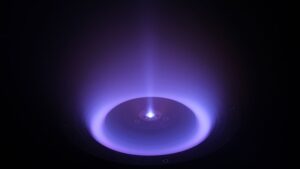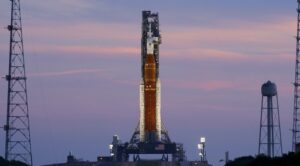Astra to sell electric thrusters to Airbus OneWeb Satellites
Tuesday, 30 August 2022 08:58
Astra Space announced Aug. 29 it won a contract from Airbus OneWeb Satellites to provide electric propulsion systems for the Arrow line of small satellites.
The post Astra to sell electric thrusters to Airbus OneWeb Satellites appeared first on SpaceNews.
NASA scrubs launch of giant Moon rocket, may try again Friday
Monday, 29 August 2022 21:44 NASA has scrubbed a test flight of its powerful new rocket, in a setback to its plan to send humans back to the Moon and eventually to Mars, but may shoot for another launch attempt on Friday.
"We don't launch until it's right," NASA administrator Bill Nelson said after an engine issue forced a cancellation of Monday's flight from the Kennedy Space Center in Florida.
"This is a very comp
NASA has scrubbed a test flight of its powerful new rocket, in a setback to its plan to send humans back to the Moon and eventually to Mars, but may shoot for another launch attempt on Friday.
"We don't launch until it's right," NASA administrator Bill Nelson said after an engine issue forced a cancellation of Monday's flight from the Kennedy Space Center in Florida.
"This is a very comp Direct-to-cell startups welcome Musk’s arrival
Monday, 29 August 2022 21:24
Startups developing constellations for providing connectivity directly to standard cellphones say they stand to benefit from SpaceX entering their market.
The post Direct-to-cell startups welcome Musk’s arrival appeared first on SpaceNews.
NASA continues to study issues that caused Artemis 1 launch scrub
Monday, 29 August 2022 20:08
NASA officials say they are keeping open the possibility of attempting another launch of the Artemis 1 mission as soon as Sept. 2 as they continue to study a pair of issues that scrubbed the initial launch attempt Aug.
New head of AFRL space vehicles looking for talent to help push technology forward
Monday, 29 August 2022 18:50
AFRL is looking to shore up its technical workforce and to partner with private companies, said Col. Jeremy Raley, head of the space vehicles directorate
The post New head of AFRL space vehicles looking for talent to help push technology forward appeared first on SpaceNews.
First in-situ temperature measurement of the thermophysical properties of lunar farside regolith
Monday, 29 August 2022 17:20
Lunar regolith is a layer of loosely-packed rocky grains deposited on the lunar surface, whose physical and chemical properties are important for deciphering the geologic history and formulating lunar spacecraft design. Probing the thermal conductivity of the lunar regolith has drawn a lot of attention since the Apollo era. Early measurements focused on the Apollo regolith samples, but the experimental data were available only at a few landing sites at the nearside.
The CE-4 spacecraft landed at 45.4446°S, 177.5991°E, on the floor of Von Kármán crater, on January 3rd, 2019. After landing, the Yutu-2 rover was released via the deployed two rails.
A centered error entropy-based sigma-point Kalman filter for spacecraft state estimation with non-Gaussian noise
Monday, 29 August 2022 17:06
A spacecraft attitude kinematics model, attitude measurement model, and filter algorithm are three important parts in spacecraft attitude determination, and a high-precision filtering algorithm is the key to attitude determination. The classical sigma-point Kalman filter (SPKF) is widely used in a spacecraft state estimation area with the Gaussian white noise hypothesis.
Although the SPKF algorithm performs well in ideal Gaussian white noise, the actual operating conditions of the spacecraft in orbit are complicated. Space environmental interference, solar panel jitter, and flicker noise will make the noise no longer meet the Gaussian distribution and present a heavy-tailed non-Gaussian situation, where the classical SPKF filtering method is no longer applicable, and there will be obvious accuracy degradation or even filtering divergence.
In a research paper recently published in Space: Science & Technology, a joint team from the Army Engineering University of PLA and Chinese Academy of Military Science, proposed a robust Centered Error Entropy Unscented Kalman Filter (CEEUKF) algorithm by combining the deterministic sampling criterion with the centered error entropy criterion.
NASA says Friday launch of giant Moon rocket possible
Monday, 29 August 2022 16:37
A test flight of NASA's powerful new Moon rocket may be possible on Friday, officials said, after the US space agency scrubbed Monday's launch because of an engine issue.
"Friday is definitely in play," Artemis 1 mission manager Mike Sarafin told reporters.
"They're still holding in the launch countdown configuration and we're preserving the option for Friday."
Explore further
© 2022 AFP
Scientist sending yeast and algae to space on Artemis 1
Monday, 29 August 2022 15:12
When NASA's Artemis 1 lunar mission takes off on August 29, on board will be four science experiments—including one from Canada.
UBC pharmaceutical sciences professor Dr. Corey Nislow is sending yeast and algae cultures into space, in a pod not much bigger than a shoebox, to study the effects of cosmic rays and near zero gravity on living organisms.
When the spacecraft returns after its uncrewed 42-day orbit around the Moon, Dr. Nislow will get his samples back, along with the information they contain.
In this Q&A, he explains what the NASA project could mean for medical advances on Earth and in space.
What is it exactly that you're sending into to space, and why?
We chose to study Chlamydomonas reinhardtii—a single-cell green alga—and 6,000 yeast mutants.
Engine issue forces NASA to scrub launch of giant Moon rocket
Monday, 29 August 2022 13:26 NASA called off a test flight on Monday of its largest-ever rocket in a setback to the ambitious program to send humans back to the Moon and eventually to Mars.
"We don't launch until it's right," NASA administrator Bill Nelson said after an engine temperature issue forced liftoff from Kennedy Space Center to be scrubbed.
"This is a very complicated machine," Nelson said. "You don't want
NASA called off a test flight on Monday of its largest-ever rocket in a setback to the ambitious program to send humans back to the Moon and eventually to Mars.
"We don't launch until it's right," NASA administrator Bill Nelson said after an engine temperature issue forced liftoff from Kennedy Space Center to be scrubbed.
"This is a very complicated machine," Nelson said. "You don't want AFRL's oscillating heat pipes are even cooler in space
Monday, 29 August 2022 13:26 The Air Force Research Laboratory, or AFRL, has released the results from its Advanced Structurally Embedded Thermal Spreader Two, or ASETS-II. The AFRL experiment was 100% effective in testing the most recent version of the revolutionary Oscillating Heat Pipes, or OHPs, and the results of the more than 6,600 hours of on-orbit testing are being made available to the public.
"We now have a
The Air Force Research Laboratory, or AFRL, has released the results from its Advanced Structurally Embedded Thermal Spreader Two, or ASETS-II. The AFRL experiment was 100% effective in testing the most recent version of the revolutionary Oscillating Heat Pipes, or OHPs, and the results of the more than 6,600 hours of on-orbit testing are being made available to the public.
"We now have a T-Mobile Takes Coverage Above and Beyond With SpaceX
Monday, 29 August 2022 13:26 In a live event, T-Mobile (NASDAQ: TMUS) CEO and President Mike Sievert and SpaceX Chief Engineer Elon Musk announced Coverage Above and Beyond: a breakthrough new plan to bring cell phone connectivity everywhere. Leveraging Starlink, SpaceX's constellation of satellites in low Earth orbit, and T-Mobile's industry-leading wireless network, the Un-carrier plans to provide near complete coverage i
In a live event, T-Mobile (NASDAQ: TMUS) CEO and President Mike Sievert and SpaceX Chief Engineer Elon Musk announced Coverage Above and Beyond: a breakthrough new plan to bring cell phone connectivity everywhere. Leveraging Starlink, SpaceX's constellation of satellites in low Earth orbit, and T-Mobile's industry-leading wireless network, the Un-carrier plans to provide near complete coverage i NS-23 to Fly 36 Payloads and 1000s of Club for the Future Postcards to Space
Monday, 29 August 2022 13:26 On August 31, New Shepard's 23rd mission, a dedicated payloads flight, will fly 36 payloads from academia, research institutions, and students across the globe. The launch window opens at 8:30 AM CDT / 13:30 UTC from Launch Site One in West Texas.
This mission brings the total number of commercial payloads flown on the vehicle to more than 150. Two of the payloa
On August 31, New Shepard's 23rd mission, a dedicated payloads flight, will fly 36 payloads from academia, research institutions, and students across the globe. The launch window opens at 8:30 AM CDT / 13:30 UTC from Launch Site One in West Texas.
This mission brings the total number of commercial payloads flown on the vehicle to more than 150. Two of the payloa Perseverance rover retrieves key rocky clues to Mars' geologic and water history
Monday, 29 August 2022 13:26 In its first year exploring Jezero Crater on Mars, the Perseverance rover collected rock samples that scientists anticipate will provide a long-awaited timeline for the planet's geologic and water history.
They'll just have to wait a decade to find out the answer, until the samples can be scooped up from the surface and returned to Earth for dating in 2033.
The scientists are neverth
In its first year exploring Jezero Crater on Mars, the Perseverance rover collected rock samples that scientists anticipate will provide a long-awaited timeline for the planet's geologic and water history.
They'll just have to wait a decade to find out the answer, until the samples can be scooped up from the surface and returned to Earth for dating in 2033.
The scientists are neverth DART team confirms orbit of targeted asteroid
Monday, 29 August 2022 13:26 Using some of the world's most powerful telescopes, the DART investigation team last month completed a six-night observation campaign to confirm earlier calculations of the orbit of Dimorphos-DART's asteroid target-around its larger parent asteroid, Didymos, confirming where the asteroid is expected to be located at the time of impact. DART, which is the world's first attempt to change the speed
Using some of the world's most powerful telescopes, the DART investigation team last month completed a six-night observation campaign to confirm earlier calculations of the orbit of Dimorphos-DART's asteroid target-around its larger parent asteroid, Didymos, confirming where the asteroid is expected to be located at the time of impact. DART, which is the world's first attempt to change the speed 
